All-electric Porsche Taycan Ushers in a New Era at Porsche
NIAGARA, Ontario – The two electric motors rev up to 16,000 rpm and generate a total of 617 horsepower (750 with the overboost function) along with 774 pound-feet of torque, sending the all-new Porsche Taycan Turbo S from 0-100 km/h in 2.8 seconds and from 0-200 km/h in 9.8 seconds.
This electric sedan can do a full lap of the Nürburgring-Nordschleife in 7:42 minutes. It weighs 2,323 kilograms and reaches a top speed of 260 km/h. Impressed yet?
- Also: Hop in the New Porsche Taycan for a Record Lap at the Nürburgring
- Also: 2020 Porsche Taycan Interior Revealed Ahead of its Official Debut
Surprisingly, Porsche decided to retain the Turbo and Turbo S names even without a combustion engine under the body. Why? Just to keep things simple and familiar for Porsche customers. In fact, we’ve learned that base and 4S variants are coming, as well, though no official information is available yet.
A few weeks prior to today’s world premiere in Germany, The Car Guide was invited to a seminar where the company would discuss the car that ushers in a new era at Porsche. We also got the opportunity to drive the aforementioned Taycan Turbo S on a very technical, albeit short track, two skidpads (one dry, one wet) and a slalom course.
Now that the embargo has been lifted, we can tell you all about our experience. Buckle up!
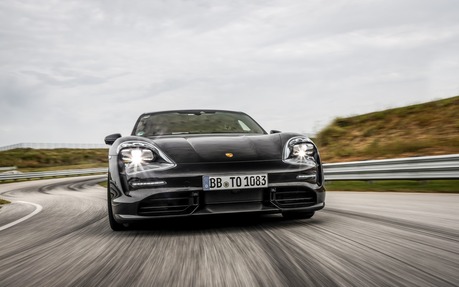
A Straight Punch to the Chest
Riding shotgun in a pre-production model driven by one of the engineers responsible for the development of the Porsche Taycan, I took the time to adjust my seat and tighten my seat belt in order to be fully ready for the exhilarating moments that would come next.
Full-throttle acceleration from a standstill is like being hit with a straight punch to the chest. I anticipated the car to explode out of the starting blocks just as ferociously as a 911 Turbo S, but since the cockpit of the Taycan remains almost completely quiet, my brain initially couldn’t process the forward surge that ensued.
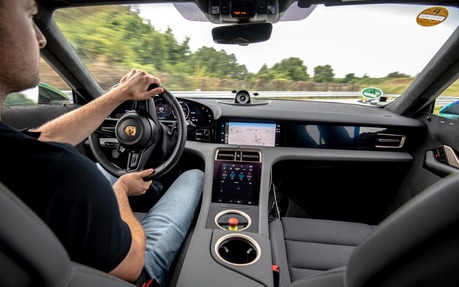
Two Motors and a Dual-speed Gearbox
The new Porsche Taycan Turbo S is motivated by a pair of electric motors: one driving the front wheels and a second driving the rear wheels. The former produces 255 horsepower and 295 pound-feet of torque, while the latter is rated at 450 horsepower and 406 pound-feet (450 with overboost).
The Taycan Turbo uses the same rear motor, but the front motor is detuned to 235 horsepower and 221 pound-feet.
In both cases, the front motor is mated to a single-speed gearbox, while the one in the rear is mated to a dual-speed gearbox. It allows the Taycan to launch at a blistering pace in first gear and switch to second gear from 90-105 km/h with Sport mode activated. In Range mode, the rear transmission stays in second gear at all times.
The two motors draw energy from a 93-kWh battery made up of 396 cells mounted in the floor, except in the area where the rear passengers lay their feet to maximize legroom. Clever, isn’t it?
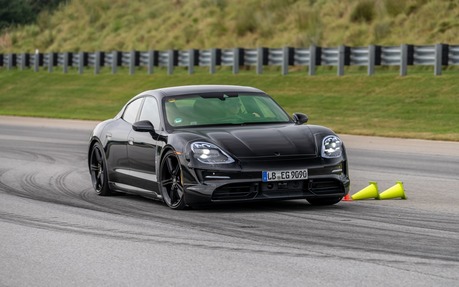
A hard press on the brake pedal results in massive deceleration. Unlike many other electric cars, the Taycan’s energy recuperation system only works when you apply the brakes, not when you simply release the throttle. This way, it preserves the dynamics of a gasoline-powered sports car.
The Turbo S model features huge 420-mm ceramic composite discs with 10-piston callipers up front (painted in yellow) and 410-mm discs with four-piston callipers in the rear. The Turbo’s front binders are white and clamp 415-mm discs, while those in the rear have 365-mm discs to slow down.
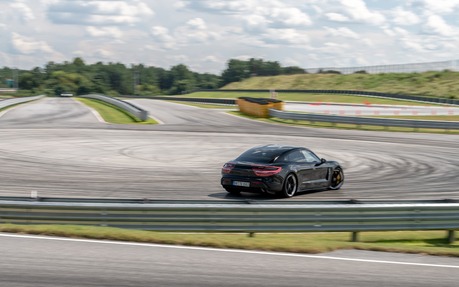
Air Suspension
The three-chamber air suspension on the Porsche Taycan is derived from the Panamera and uses specific tuning. Porsche Dynamic Chassis Control is available to eliminate virtually all body roll in corners (even the sharpest ones) and disconnect the sway bars to enhance comfort in straight lines.
The car’s ride height can be lowered by 22 mm in Sport mode or at speeds beyond 180 km/h. As mentioned earlier, top speed is rated at 260 km/h for both the Taycan Turbo and Taycan Turbo S. Meanwhile, the electronically controlled all-wheel drive system reacts much faster than a conventional AWD system and the Panamera-sourced rear-axle steering further improves handling.
In tight corners, the Taycan Turbo S couldn’t hide its substantial weight, but I was amazed by its tenacious grip and lively dynamics. The 21-inch wheels with 265/35R21 front and 305/30R21 rear tires are part of the reason why.
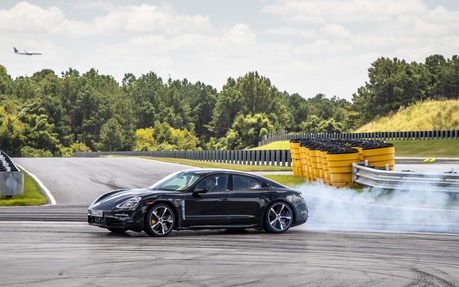
Donuts and the Smell of Burnt Rubber
Drifting a Porsche Taycan Turbo S in circles on a skidpad is child’s play thanks to the rear motor’s phenomenal torque and rear-biased AWD system. We had a good laugh as the tires screamed and evaporated on dry pavement.
After that came a hard braking test on a wet skidpad followed by a slalom course that highlighted the effectiveness of Porsche’s driver assistance features, which are all part of the equation in the Turbo and Turbo S models.
Active Aerodynamics
Porsche engineers took a holistic approach to develop the aerodynamics for the Taycan, whose drag coefficient is a spectacular 0.22 in Turbo trim and 0.25 in Turbo S trim—the best ever for a Porsche.
Up front, both variants are equipped with active vertical shutters that open to maximize cooling and close to reduce drag. In the rear, the active spoiler stays hidden at idle, partially deploys in Eco mode and fully extends in Sport mode.
Charging
The Taycan offers not one, but two charging ports. The one on the driver’s side is dedicated to level-2 charging, while the one on the passenger side is designed for fast charging.
When using a conventional level-2 charging station that supplies 240 volts at 9.6 kilowatts, charging takes 11 hours. If you plug the car into a 50-kW fast-charging station, restoring the battery from 5-80 percent can be done in 93 minutes. The same operation with a 270-kW power source takes just 22.5 minutes—or 40-45 minutes in 0°C weather since the battery needs to reach its optimum temperature of 30°C.
All 32 fast-charging stations in the Electrify Canada network are capable of supplying 350 kilowatts. They are separated by an average distance of 120 kilometres between Vancouver and Calgary as well as between Windsor and Quebec City.
The Taycan Turbo is said to deliver a range of 381-450 kilometres based on the WLTP standard, while the Turbo S model achieves 388-412 kilometres.
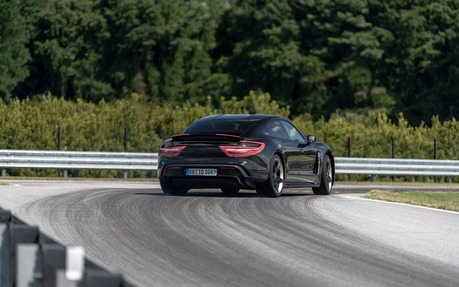
Fully Digital Cockpit
Inside the Porsche Taycan, you’ll find a fully digital and configurable cockpit as the instrument panel was replaced with a 16.8-inch curved display and a 10.9-inch touchscreen resides in the middle of the dashboard. A bit lower is an 8.4-inch display for the HVAC system and other functions.
A fourth touchscreen measuring 10.9 inches (optional) faces the front passenger and gives access to pretty much everything except drive mode selection and driver notifications.
We at The Car Guide will spend some quality time with the production Taycan Turbo and Taycan Turbo S in two weeks. Don’t miss our comprehensive review!
